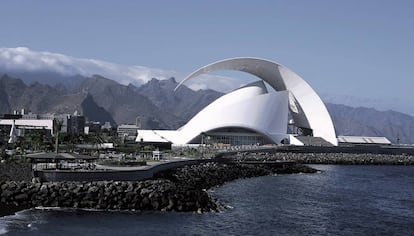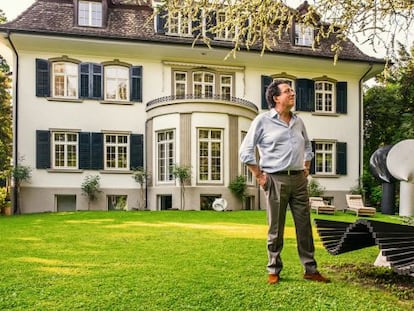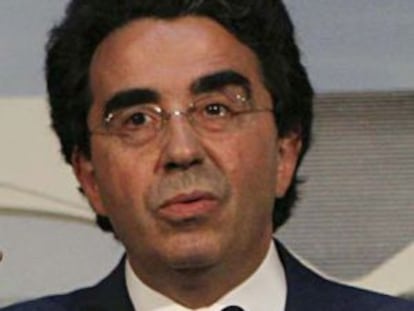Santiago Calatrava: the fallen idol?
New book charts the fortunes and reputation of Spain’s most famous architect


Santiago Calatrava is nothing if not a paradox: revered as Spain’s best-known contemporary Spanish architect, he is also reviled by his critics as mercenary and self-obsessed. In the space of 30 years, the 67-year-old has gone from being feted as a latter-day Gaudi to embodying professional irresponsibility and dubious ethics; a man who can always be relied on to deliver behind schedule and way over budget, and whose multi-million projects, whether they be slippery bridges or mobile mechanisms, have often ended up immobilized.
The initial pomp that heralded each new undertaking around the world, and the subsequent complications during construction, have been amply covered by the media over the years. But this does not explain why Calatrava switched from being the hottest architect around to the most demonized.
Calatrava’s slide into disrepute coincided with his arrival in New York
Now journalist Llàtzer Moix offers an insight into Calatrava’s fall from grace in his latest book, Queríamos un Calatrava (We wanted a Calatrava), published by Anagrama. Moix describes a man elevated to god-like status, a talented artist, but an arrogant individual convinced of his place in the history books.
“How would you feel if I asked you to come and sweep my studio?” was reportedly Calatrava’s reply when Alberto Estévez, the founder of Catalonia University’s Higher School of Architecture, suggested Calatrava might like to give some classes there.
According to Enrique Amigó, an engineer who was trying to sort out the many headaches created by Calatrava’s €200 million auditorium in Tenerife, the architect once said: “Just so you know, you are talking to me from your island which is in the butt-end of Europe and I am talking from Zurich which is at the heart of Europe. Your island doesn’t deserve me.”
Based on statements and opinions from former employees, colleagues and clients, from Athens to New York, the book offers a telling insight into how politicians allowed Calatrava to undertake public projects without the proper permits and without having presented a detailed budget. Written with humor and rigorously documented, it lacks only one thing: comment from the architect himself. “His people told me that he wasn’t interested in collaborating with anything that might be critical of him,” says Moix.
Calatrava was elevated to god-like status, and is convinced of his place in the history books
Calatrava is no stranger to flack. In 2012, Ignacio Blanco of Valencia’s left-leaning EUPV party set up a web page called www.calatravatelaclava.com (a play on words that means something like “Calatrava is a gouger”) to expose the architect’s cozy relationship with the regional government in Valencia. There were 80,000 hits on the first day, while details from the website were picked up by the international media. Calatrava took the EUPV to court and won €30,000 in compensation. The web then shifted to a different site, namely www.calatravanonoscalla.com (“Calatrava won’t silence us), and asked its subscribers for help with costs. Another court action by Calatrava failed to close the second website down.
Not that all Calatrava’s projects have sparked controversy – the expansion of Milwaukee’s Art Museum, which was completed on time even if it was four times over the budget; and the Venetian bridge he was contracted to design by former mayor Massimo Cacciari. “It’s surprising that a person of Cacciari’s intellect would believe that a bridge by Calatrava could significantly change the image of Venice,” writes Moix referring to a city that turned down a hospital by Le Corbusier, a building by Frank Lloyd Wright and an airport by Frank Gehry.
The freshness with which Moix writes and the inclusion of anecdotes such as the story behind the Caja Madrid column in Plaza Castilla make for a compelling read. Miguel Blesa, the former president of the regional savings bank sought Calatrava out to design a monument. “The absence of a Calatrava in Madrid hurt,” said Alberto Ruiz Gallardón, the city’s mayor at the time, and who, according to Moix, “ irresponsibly ignored what its maintenance would cost or, even more irresponsibly, accepted it without finding out how much it would be.”
The book describes a man elevated to god-like status, a talented artist, but an arrogant individual
The tale of Calatrava’s gold column in Madrid is revealing. He invested 65% of the budget in bronze which, in the end, was plated in gold. Calatrava failed to turn up to its inauguration in 2009, which was presided over by the former King Juan Carlos, with few of the officials that had commissioned it present. What nobody seems to have remembered was that there already was a sculpture by Calatrava in Madrid – in the gardens of the Zarzuela Palace, not far from a piece by Eduardo Chillida.
By the end of the 20th century, Calatrava had offices in various cities around the world, having progressed from building bridges to creating iconic buildings, and all the while his popularity increasing. And he remained in demand, even after things started to go wrong. So why were his clients not put off by his record? Moix believes it was down to investments and contracts.
Though Spain has found it hard to accept, the fact is that Calatrava’s slide into disrepute coincided with his arrival in New York, where he accepted the task of building the transport hub on the Ground Zero site. In the space of five years, Calatrava went from being lauded as the “dove” to being slated as “the porcupine”. The New York Times called his transportation hub “a monument to the creative ego” while The Wall Street Journal labeled it “an embarrassment.”
English version by Nick Lyne.
Tu suscripción se está usando en otro dispositivo
¿Quieres añadir otro usuario a tu suscripción?
Si continúas leyendo en este dispositivo, no se podrá leer en el otro.
FlechaTu suscripción se está usando en otro dispositivo y solo puedes acceder a EL PAÍS desde un dispositivo a la vez.
Si quieres compartir tu cuenta, cambia tu suscripción a la modalidad Premium, así podrás añadir otro usuario. Cada uno accederá con su propia cuenta de email, lo que os permitirá personalizar vuestra experiencia en EL PAÍS.
¿Tienes una suscripción de empresa? Accede aquí para contratar más cuentas.
En el caso de no saber quién está usando tu cuenta, te recomendamos cambiar tu contraseña aquí.
Si decides continuar compartiendo tu cuenta, este mensaje se mostrará en tu dispositivo y en el de la otra persona que está usando tu cuenta de forma indefinida, afectando a tu experiencia de lectura. Puedes consultar aquí los términos y condiciones de la suscripción digital.
More information
Últimas noticias
The complicated life of Francesca Albanese: A rising figure in Italy but barred from every bank by Trump’s sanctions
Half of Scotland is in the hands of 420 property owners
Reinhard Genzel, Nobel laureate in physics: ‘One-minute videos will never give you the truth’
Pinochet’s victims grapple with José Antonio Kast’s rise in Chile
Most viewed
- Pablo Escobar’s hippos: A serious environmental problem, 40 years on
- Why we lost the habit of sleeping in two segments and how that changed our sense of time
- Charles Dubouloz, mountaineering star, retires at 36 with a farewell tour inspired by Walter Bonatti
- Trump’s obsession with putting his name on everything is unprecedented in the United States
- The Florida Keys tourist paradise is besieged by immigration agents: ‘We’ve never seen anything like this’










































